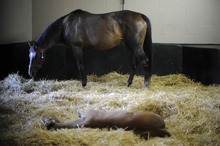Saying, "A combination of growth, nutrition and inheritance likely come into play," Dr. Ed Kane, writing in DVM News Magazine, urges horse owners and breeders to be on the look-out for osteochondrosis in their young horses and foals.

A cause of lameness in foals
Osteochondrosis is a manifestation of developmental orthopedic disease widely recognized in young horses across many breeds.
© 2012 by Carien Schippers
Osteochondrosis is a manifestation of developmental orthopedic disease widely recognized in young horses across many breeds. This condition is of particular interest because of its potential to cause joint effusion and lameness in horses preparing for yearling sales or entering training.
Osteochondrosis affects many horses, with estimates that more than 60 percent are found in some radiographic surveys. Although surgical treatment is often a cure, severe or untreated lesions can lead to long-term consequences including lameness.
Despite its great impact on the horse industry, the risk factors contributing to osteochondrosis development are not fully understood. As new findings from researchers emerge, previous theories are being revised, and a more definitive picture of its etiology, genetics, metabolic profile and treatment are on the horizon.
Other conditions fall within the developmental orthopedic disease spectrum, including angular limb deformities ("crooked-legged foals"), physitis, subchondral bone cysts, cuboidal bone malformation (collapsed or crushed carpal and tarsal bones), cervical vertebral malformation (wobbler syndrome) and flexural limb deformity. However, these conditions are quite disparate, and while some risk factors may be shared among them, their pathophysiologies are distinct from that of osteochondrosis.
